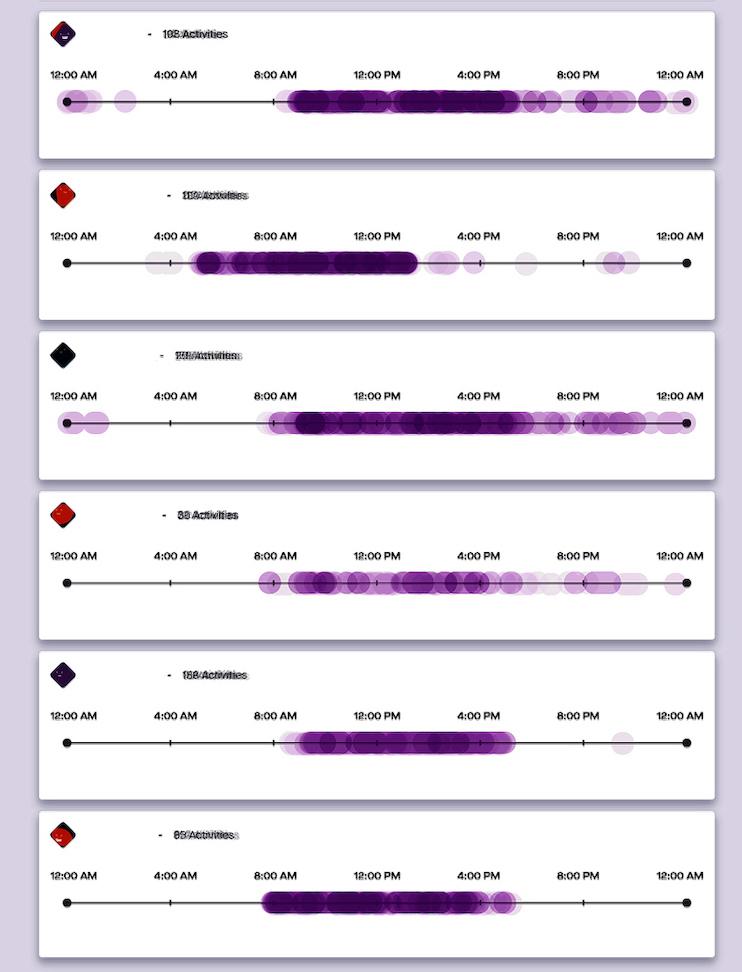Produce8
MSPs looking for the Produce8 Playbook, look no further!
There’s more work flexibility than ever before, which is great. But despite what you might think, most of us still have no clear concept of what our digital workdays really look like. We know we spend time toggling between individual work and collaborative work with our team members, but let’s be honest. The timeline of all that gets a little blurry.
And after you wade through all the noise of meetings, messages and notifications, how much time is left over?
Try considering your own average digital work day:
- What percentage of the day are you spending—or perhaps whiling away—in communication and collaboration software?
- Which tools are you spending the majority of your time in? And how often are you context switching between them?
- How much time are you actually spending working freely without digital distraction or interruption?
Now extrapolate that to your entire team. What does all of this mean for your productivity, your work output and your day-to-day wellbeing as employees and human beings?
So let’s get down to it. Let’s explore the truth about digital work and the problems we need to face for a better future of work.
What are the problems with digital work?
So many of us work digitally now, which gives us access to endless information and capability right at our fingertips. It connects us with each other in ways we previously never thought possible. And it untethers us from physical proximity and restrictive work schedules.
But digital work is still far from perfect.
“According to a Gartner survey, 67% of organizations increased the use of digital platforms since 2019. But organizations haven’t met the moment with a similar embrace of digitally optimized processes and methods to help teams get their work done.”
Even companies that think they’re responding to the needs of the new digital workspace are missing the mark as 67% of today’s employees say they feel the technology they use for work takes more effort than it should.
“People may feel overwhelmed by the constant input, but some believe they have become multitaskers: they imagine they can continually toggle back and forth [between apps and work] without losing an ounce of efficiency,” said Elena Pasquinelli in a 2018 article in Scientific America. “But a body of research confirms that this impression is an illusion. When individuals try to do two or more things at once that require their attention, their performance suffers.”
Let’s be honest, we’re ALL always trying to do two or more things at once. We’re answering Slack messages while we’re on Zoom calls. We’re checking our email while we’re working on projects. And we’re jumping back and forth between our work and the continual pings of our notifications.
The good news, wrote Pasquinelli, is that we don’t need to rewire our brains to preserve our attention spans.
“You can help yourself by thinking about what distracts you most and by developing strategies to immunize yourself against those distractions.”
The problem is, we don’t really know what distracts us most.
Real-talk about digital distraction and disruption
According to time-tracking software Clockify, 70-99% of office employees feel distracted during the workday. So, that’s almost everyone.
The average employee gets interrupted as much as 56 times a day. And what happens after someone gets distracted or interrupted? Over the course of the day, employees are each taking about two hour to refocus on their work. And not only do distractions lead to wasted time, they can also negatively impact our actual work performance.
According to a study from Michigan State University, even distractions as brief as three seconds can double our error rate.
“So why did the error rate go up?” asked Erik Altmann, lead researcher on the study.
“The answer is that the participants had to shift their attention from one task to another. Even momentary interruptions can seem jarring when they occur during a process that takes considerable thought.”
Our team at Produce8 recently spent a couple of weeks measuring our Slack usage to get a better understanding of how this particular tool punctuates our workdays and how it could be impacting our performance. The results were pretty astounding.

Each purple circle in each timeline represents a new Slack instance.
- Not a single one of us went more than 15 minutes in a standard 8-hour workday without using Slack. (Other data suggests average users of communication-collaborations tools like this check them as often as every five minutes .) No doubt some of our Slack-use instances were self-driven while others were incited by pings and notifications.
- We’re each spending at least an hour a day in this tool—which doesn’t account for the time lost to context switching between it and our other work applications.
- And many of our team members are being pulled back into work communications well outside of reasonable working hours.
Important note: this experiment didn’t even include our team’s usage of the Slack mobile app, which undoubtedly would have added to the noise above—especially the after-hours usage. And stay tuned. We’ll be digging into our findings and take-aways from this Slack experiment in an upcoming article!
Slack and the many other tools we use to assist us in our digital workdays—from communication and collaboration tools, to productivity enhancers and process automators—are all great in theory. But are we using them as effectively as we could be, or are we just adding more noise and distraction?
Between all the Slack usage, the two to four hours a day we spend in meetings, and all the time we need to just get refocused from our context switching, how much work can we really get done?
Why do we keep ignoring the problems?
It’s not that we’re ignoring the problems with our current digital work model per se. It’s more that we:
- can’t precisely identify—or perhaps prove—what the problems are
- have trouble identifying when and how often they occur during the work day, and
- don’t exactly know how we should go about solving them.
Once we truly start to see what digital work looks like for us as individuals and teams, we can begin to measure what we see. We can uncover exactly where time’s being drained, how often we’re context switching and precisely where distraction is happening and we’re losing all that valuable work productivity.
We’re also likely to uncover the source of much of the digital disorganization and chaos that’s causing us so much stress and burnout. According to a 2021 survey by the American Psychological Association, nearly 80% of participants had experienced work-related stress in the month prior to the survey.
If starting to identify your team’s unique digital work challenges sounds like a good path forward for you and your team, we encourage you to sign up for free early access to our tool. You’ll get everything you need to start running your own digital work experiments so your team members can better understand how they’re really using your technology through the digital workday.
We guarantee this is going to spark interesting conversations and hopefully lead to some very positive changes for your team.
Let’s build a better future of digital work
Businesses need to commit to uncovering the truth about their own digital work problems. They won’t be the same for every organization.
Businesses first need to understand what their teams’ digital workdays look like. This will enable them to identify problematic patterns and workflows that are causing distraction and preventing progress.
This can provide:
- proof that their people are being distracted and aren’t being given ample opportunities to really concentrate on getting work done, and
- clarity around the profound effect productivity loss is having on business.
With this knowledge, businesses can support changes toward more effective work patterns and then measure the outcomes of those changes. Because without the ability to measure, there’s a lack of assurance that changes have had the desired impact.
Then, businesses need to adopt more effective digital work processes, policies and tools that embrace a new kind of work hub for their teams. According to Gartner , “The “new work hub” assembles productivity applications to serve diverse needs.”
Talk to your team, start understanding where the problems and concerns exist, and start developing a plan for a better future of digital work.
Related Aritcles
Digital Work Analytics reporting
AIRO Part 4 - From Reactive IT to Managed AI - The Next Evolution for MSPs
2 min read
Unlock great workdays
Wether you are collaborating with your team or solo tackling your day we can help you recover the most valuable asset, time.
